
Passiflora edulis, commonly known as passion fruit, is a vine species of passion flower native to the region of southern Brazil through Paraguay to northern Argentina. It is cultivated commercially in tropical and subtropical areas for its sweet, seedy fruit.

Passiflora, known also as the passion flowers or passion vines, is a genus of about 550 species of flowering plants, the type genus of the family Passifloraceae.
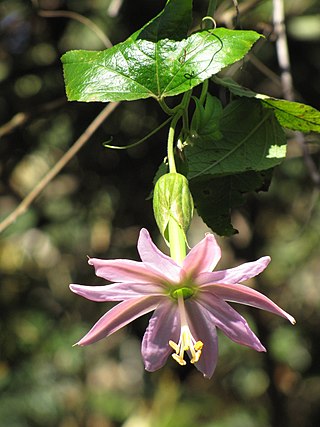
Passiflora tarminiana is a species of passionfruit. The yellow fruits are edible and their resemblance to small, straight bananas has given it the name banana passionfruit in some countries. It is native to the uplands of tropical South America and is now cultivated in many countries. In Hawaii and New Zealand it is now considered an invasive species. It was given the name banana passionfruit in New Zealand, where passionfruit are also prevalent. In Hawaii, it is called banana poka. In its Latin American homeland, it is known as curuba, curuba de Castilla, or curuba sabanera blanca (Colombia); taxo, tacso, tagso, tauso (Ecuador); parcha, taxo (Venezuela), tumbo or curuba (Bolivia); tacso, tumbo, tumbo del norte, trompos, tintin, porocsho or purpur (Peru).

Banana passionfruit, also known as taxo and curuba, is a group of around 64 Passiflora species found in South America. Most species in this section are found in high-elevation cloud forest habitats. Flowers have a cylindrical hypanthium.
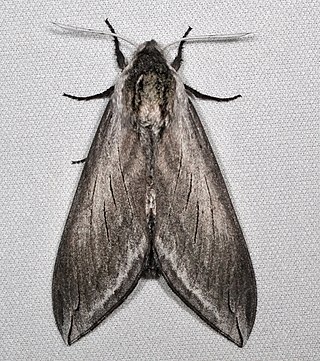
Sphinx perelegans, commonly known as the elegant sphinx, is a species of hawkmoth described by Henry Edwards in 1874. It is a large gray moth native to western North America.

The ʻakekeʻe or Kaua'i 'akepa is a bird species in the family Fringillidae, where it is placed in the Hawaiian honeycreeper genus Loxops. It is endemic to the island of Kauaʻi where it is found in small numbers in higher elevations. Because of their similar size, shape, and unusual bill, the ʻakekeʻe and the ʻakepa were for some time classified as a single species. This was eventually changed, because of differences in their color, nesting behavior, and calls. The 'akeke'e is extremely threatened and is predicted to face imminent extinction if mosquito control efforts on Kaua'i are not implemented.

Omiodes is a moth genus in the family Crambidae. Several species are endemic to Hawaii.
The Maui banana hedyleptan moth is a species of moth in the family Crambidae. It was described by Otto Herman Swezey in 1909 and is endemic to the Hawaiian islands of Molokai and Maui.
Nothocestrum peltatum, the Oʻahu ʻaiea, is a species of flowering plant in the nightshade family, Solanaceae, that is endemic to the island of Kauaʻi in Hawaiʻi. It can be found in mesic forests at elevations of 915–1,220 metres (3,002–4,003 ft). There are only about 23 individuals remaining.

Passiflora tripartita also called curuba, tumbo, curuba de Castilla and tumbo serrano is a species of Passiflora from Peru, Bolivia, Ecuador, Colombia, and Brazil in areas at elevations of 2000 – 3200 meters.
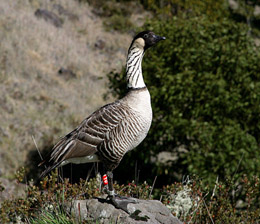
Hakalau Forest National Wildlife Refuge is a protected area on the Big Island of Hawaiʻi. It is one of two units, along with the Kona Forest National Wildlife Refuge that is managed as part of the Big Island National Wildlife Refuge Complex. Access to the Kona Forest is restricted since it contains several endangered species.

Omiodes blackburni, the coconut leafroller, is a species of moth in the family Crambidae. It is endemic to the Hawaiian islands of Kauai, Oahu, Molokai, Maui, Lanai and Hawaii. The species was first described by Arthur Gardiner Butler in 1877.

Hypocala deflorata is a moth of the family Erebidae. It was first described by Johan Christian Fabricius in 1794. It is widespread from India, Sri Lanka to Africa and to Australia and many Pacific islands. Records include China, Borneo, Queensland, Vanuatu, New Caledonia, Rotuma, Fiji, Samoa, Hawaii, Norfolk Island and New Zealand.
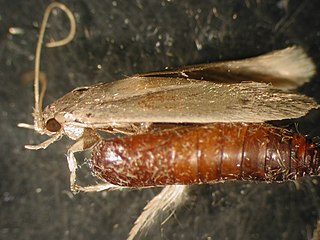
Opogona sacchari, the banana moth, is a moth of the family Tineidae. The species was first described by Wenceslas Bojer in 1856. It is native to the humid tropical and subtropical regions of sub-Saharan Africa, where it is also found in Madagascar, Mauritius, Réunion, Rodrigues Island, the Seychelles and St. Helena. It was first reported from the Canary Islands in the 1920s. In the 1970s, it was introduced into Brazil and Central America, and also appeared in Europe. It has been reported from Florida since 1986.
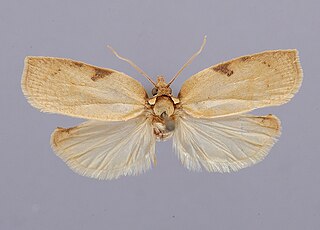
Amorbia emigratella, the Mexican leaf-roller, is a moth of the family Tortricidae. Although it was described from Hawaii, it is known to be a native of the southern United States, Mexico and Central America. It was first described by August Busck in 1910.
Exocarpos luteolus is a rare species of flowering plant in the sandalwood family known by the common names leafy ballart or heau. It is endemic to Hawaii, where it is known only from the island of Kauai. There are eight populations remaining, for a total global population of only 39 individuals. The plant was federally listed as an endangered species of the United States in 1994.

Passiflora mixta, from the family Passifloraceae is also known as curuba, curuba de indio, curuba de monte, curubita, parcha, and taxo. Originally, it derived from the monophyletic Passiflora subgenus Tacsonia. Passiflora mixta is endemic to the Americas. A perennial vine, the Passiflora mixta is pink to orange-red in color.
Schiedea kauaiensis is a rare species of flowering plant in the family Caryophyllaceae known by the common name Kauai schiedea. It is endemic to Hawaii, where it is known only from the island of Kauai. It is threatened by the degradation and destruction of its habitat. It was federally listed as an endangered species of the United States in 1996.

Solanum sandwicense is a rare species of flowering plant in the nightshade family known by the common names Hawai'i horsenettle and popolo 'aiakeakua. It is endemic to Hawaii, where it occurs today on the islands of Kauai and Oahu. It is threatened by the destruction and degradation of its habitat. It is a federally listed endangered species of the United States.












